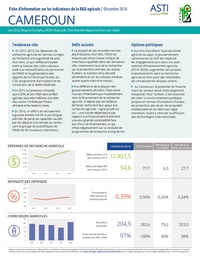Authors:
Léa Vicky Magne Domgho, Didier Begoude, Tata Precillia Ngome and Gert-Jan Stads
Year:
2018
Publisher
International Food Policy Research Institute and Institut de Recherche Agricole pour le Développement.
Back to:
Key trends
- Agricultural research expenditures increased by close to one-third during 2012–2015 (in inflation-adjusted terms), largely driven by rising salary costs following a reclassification of IRAD staff and increased funding from France through CD2—a program cancelling and converting bilateral debt.
- In 2015, Cameroon invested just 0.39 percent of its AgGDP in agricultural R&D, which remains well below the 1 percent minimum target recommended by the African Union and the United Nations.
- Following years of capacity losses due to retirement, large scale recruitment added 90 new researchers to IRAD’s pool of scientists in 2016.
Current challenges
- The bulk of IRAD’s recent recruits were MSc-qualified. IRAD continues to lack a critical mass of highly qualified researchers in a number of key areas, including animal production, fruit tree research, nutrition and food security, and indigenous food crops other than maize and cassava.
- In contrast to most countries in Africa, the Cameroon government plays a relatively limited role in funding agricultural research. Recent increases in donor funding in support of agricultural research are a positive sign. However, excessive donor dependency enhances the vulnerability to funding shocks, with negatively impact the continuation of long-term research programs.
Policy options
- In order to accelerate agricultural productivity, the Cameroon government needs to live up to its commitments in its National Agricultural Investment Plan (2014–2020) and increase its own investment in agricultural research, and take advantage of knowledge spillovers from neighboring countries.
- The private sector funding potential remains largely untapped in Cameroon. Cultivating private funding involves providing a more enabling policy environment in terms of tax incentives, protection of intellectual property rights, and regulatory reforms to encourage the spill-in of international technologies.

